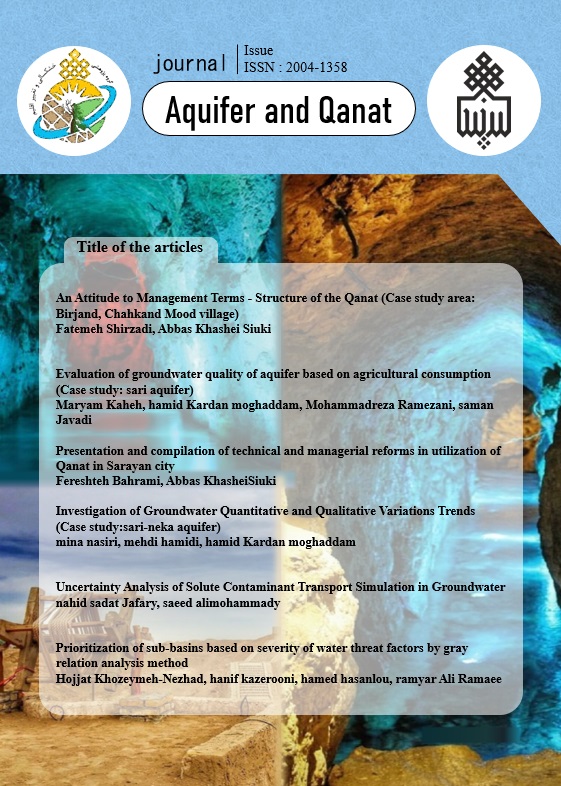Ahmadi, H., Esmaeilpour, Y., Moradi, A., Gholami, H., 2019. Assessment of land Sensitivity to Desertification Hazard Using System Dynamics Approach in the Jazmourian basin. J. of Water and Soil Conservation. 26(2), 211-223.
Daneshvar Vousoughi, F., Dinpashoh, Y., Aalami, M. T., 2011. Effect of Drought on Groundwater Level in the Past Two Decades (Case study: Ardebil Plain). Water and Soil Science. 12(4), 165-179.
Deng, J. L., 1982. Control problems of grey systems. Systems and Control Letters. 1(5): 288–294.
Jalili, J., Jalili, Kh., Hesadi, H., Hadidi, M., 2014. Artificial Recharge of Groundwater Aquifers by Surface Drainage Canals Using AHP Method. Iran-Watershed Management Science & Engineering. 8(24), 29-36.
Jalili, Kh., Moradi, H. R., Bozorg Haddad, O., 2016. Assessment of Climate Change Impacts on Water Resources in Islam Abad Aquifer and Land Allocation Optimization. Desert Ecosystem Engineering Journal. 5(11), 117-131.
Heidari Alamdarloo, E., Shokoohi, S., Barabadi, H., Rafi, J., 2014. Mapping of potential desertification areas in the country by ICCD using GIS, First National Congress of Biology and Natural Sciences of Iran, December 11, Tehran.
Karimirad, I.,
Ebrahimi, K., Araghinejad, S., 2016. The study of technical issues and utilization of a number of Qanats in Khorasan Razavi, Hamedan and Semnan provinces. Journal of Water and Irrigation Management. 5(2), 261-275.
Mehri, S., Alesheikh, A.A., Javadzade, Z., 2016. An Assessment of Changes in Groundwater Quality and Groundwater Levels in Lake Urmia Basin. Iranian Journal of ECO Hydrology.
2 (4), 395-404.
Moghaddam1, A.R., Ghallehban Tekmedash, M., Esmaili, K., 2013. Investigation of temporal and spatial trend of water quality parameters in view of weather fluctuations using GIS; Mashhad Plain. J. of Water and Soil Conservation. 20(3), 211-224.
Mora’n, J., Granada, E., Mi’guez, J.L., Porteiro, J. 2006. Use of grey relational analysis to assessand optimize small biomass boilers. Fuel Processing Technology. 87(2), 123-127.
Moridi, A., Kerachian, R., Zokaei, M., 2017. Assessment of Iran’s Water Resources Quality (2004-2014), Iran-Water Resources Research. 12 (4), 23-35.
Moslemi, H.,
Darvishi, R., 2018. Strategies to Reduce Groundwater Level Decline (The Case Study ofLavar Plain inHormozgan Province). Journal of Land Management, 5(2), 125-135.
Roson, R., Damania, R., 2016. Simulating the Macroeconomics Impact of Future Water Scarcity: and Assesment of Alternative Scenarios. Working Paper. Center for Research on Energy and Environment Economics and Policy.
Sarmadi, H., Salehi, E., Zebardast, L., Aghababaei, M., 2018. Tehran Water Quality Assessment Using DPSIR Model. Journal of Water and Soil Science. 22(2), 301-314.
Seyedan, M., Kohansal, M. R., Ghorbani, M., 2017. Achieving Optimal Path of Extracting Groundwater Resources Considering the Side Effects in Hamadan-Bahar Plain. Journal of Watershed Management Research. 8(5), 191-200.
Shahid Beheshti University, 2016. The third report on Iran’s state of environment. Technical Report, Client: Iran Department of Environmtnet, Deputy of Education and Planning.
Shahnooshi, N., Naghavi, S., Rahmati, E., 2016. The relationship between population and water crisis and its impact on macroeconomic variables. The first National conference on Water Economy, July 26-27, Tehran.
Sohrabizadeh, Z., Sharifi Moghadam, E.,
Hakimzadeh, M. A., 2018. Trend Changes Analysis of the Water Quality in the Talar River Watershed Using the Man-Kendall (MK) Test. Journal of Natural Ecosystems of Iran. 9(33), 1-20.
Teimouri, M., Sheikh, V., Sadoddin, A., 2018. Evaluation and comparison of water quality using gray relational analysis and NSFWQI in Shirin-darreh dam reservoir. Iran. J. Health & Environ. 11 (2), 170-181.
Zakerinejad, R., Masoudi, M., Afzali, F., Falah, R., 2012. Assessment of Desertification using ground water criteria and GIS (case study: Zarin Dasht Fars). Journal of Irrigation and Water Engineering. 2(3), 1-10.

